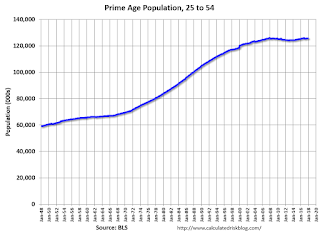by Calculated Risk on 1/08/2018 12:34:00 PM
Monday, January 08, 2018
Prime Working-Age Population nears 2007 Peak
Update through December: The prime working age population peaked in 2007, and bottomed at the end of 2012. As of December 2017, according to the BLS, there were still fewer people in the 25 to 54 age group than in 2007.
Changes in demographics are an important determinant of economic growth, and although most people focus on the aging of the "baby boomer" generation, the movement of younger cohorts into the prime working age is another key story. Here is a graph of the prime working age population (25 to 54 years old) from 1948 through December 2017.
Note: This is population, not work force.

There was a huge surge in the prime working age population in the '70s, '80s and '90s.
The prime working age labor force grew even quicker than the population in the '70s and '80s due to the increase in participation of women. In fact, the prime working age labor force was increasing 3%+ per year in the '80s!
So when we compare economic growth to the '70s, '80, or 90's we have to remember this difference in demographics (the '60s saw solid economic growth as near-prime age groups increased sharply).
The good news is the prime working age group should start growing at 0.5% per year - and this should boost economic activity.
Note: Demographics impact the unemployment rate and also appear to impact inflation. That is why I look back to the mid-60s - when the prime age population was growing slowly - to compare somewhat to today. In the '60s, the unemployment rate bottomed at 3.4% (we could see something close to that again), and inflation was below 2% for the first half of the decade. The large cohort currently moving into the prime working age is larger than the baby boom in absolute numbers, but not close as a percentage of the population. So any demographic impact on the unemployment rate and inflation going forward should be much less than in the '70s.


